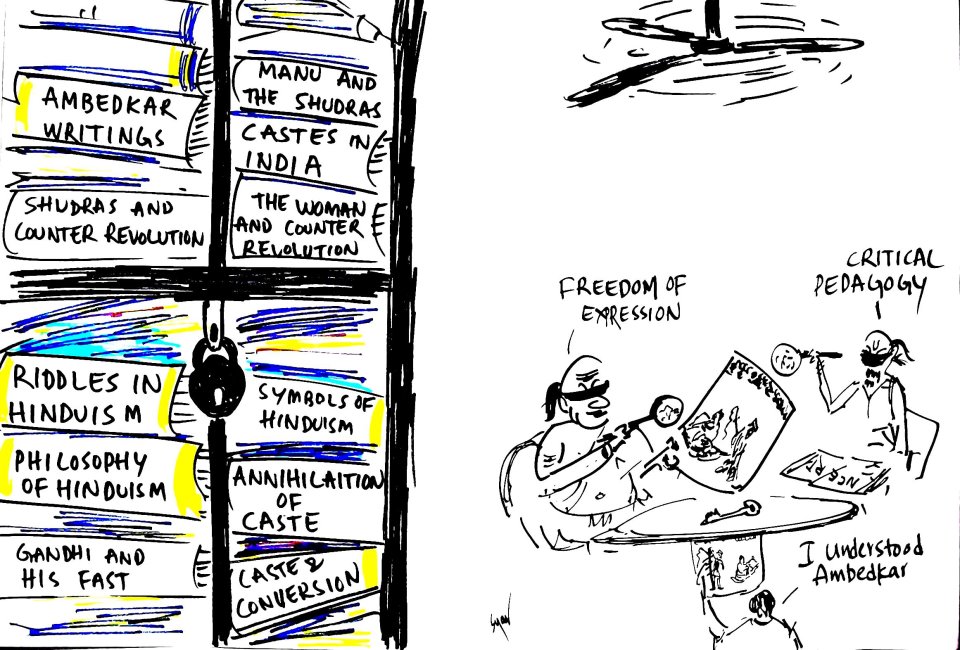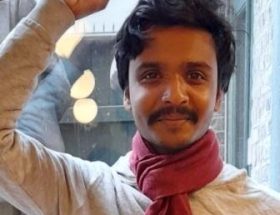Anu Ramdas
Continued from here.
‘But you came with a mind as large as the sky to my pocket size house
I thought you had ripped out all those caste things
You came bridging the chasm that divides us
Truly, friend I was really happy
With the naïve devotion of Shabari I arranged the food on your plate
But the moment you looked at the plate your face changed
With a smirk you said: Oh my—do you serve chutney koshimbir this way?
You still don’t know how to serve food
Truly, you folks will never improve
I was ashamed, really ashamed
My hand which had just touched the sky was knocked
down
I was silent
‘
~Hira Bansode
There might be a claim that not all conversations and spaces are prone to incivility. But ‘how’ they happen is key to understanding the dynamics of caste and patriarchy. Here I am not only talking about communication that flows explicitly along power relations, such as between employer and employee (both in unorganized and organized sectors), but also those that happen between people in ‘power-neutral’ or ‘polite’ spaces.
Conversing with others
Minakshee, Rupali, Jyotsna and Pradnya talk about their experiences in supposedly caste-neutral and women-centric spaces. Their commentary follows a long tradition of women poets and writers who have documented uncivil conversations characteristic of a caste society. Dalit autobiographies can be seen as running texts of such conversations between and across genders, classes, religions and regions. They record the vocabulary and grammar of caste exclusion, intimidation, humiliation and violence that underscore human interactions. Darise Shashinirmala’s poem ‘It was I who was ruined‘ and Hira Bansode’s poem ‘Bosom Friend’, show that no space, public or private is sacred to deter conversations from becoming disrespectful because of the caste of the woman (or man).
Exclusion even from women’s spaces and conversations is the larger reality for us. This has not in any way affected our faith in engaging with others towards envisioning a better society.
Savari members are in continuous conversations with men and women engaged in various kinds of feminist politics which resonate with and respond positively to anti-caste feminism. Here I am talking about feminist colleagues whose locations are not dalit, adivasi or bahujan. To name a few, Sandali Thakur, Gouri Patwardhan, Nitoo Das and others whose conversations have informed the way Savari was visualized and will continue to inform the way it evolves. Their feminism seems to take our rightful anger as something that is directed against institutions and not individuals, and they are aware that in order to move forward, naming locations is an essential and complex strategy.
Naming hierarchical difference and accountability
When we name an individual, and point to her caste location to elaborate an argument, it is done because that person’s actions or words either reflect or extend an aspect of structural injustice. The scale and intensity of anti-caste and anti-patriarchy struggles for the marginalized is so massive and so urgent that we can ill afford time focusing on persons. We are focused on the processes.
Systemic injustices cannot be fought cosmetically. One would think academics invested in understanding the processes underlying exploitation, marginalization and powerlessness, and feminists concerned with resistance strategies of the excluded would be the last to misread the politics of naming caste locations.
The politics of naming by the marginalized inverts a few paradigms; accountability is now demanded of the oppressors who until now retained for themselves this right over the slave, the dalit, the woman or the worker. It also inverts the grammar of caste, which only grants the higher castes the right to use and abuse terms indicative of caste locations– no questions are asked of this encoded caste language, all we see is a rightful participation and acceptance by the ones who are now complaining about being named for their caste location.
Let me illustrate the above point with an anecdote: in the chemistry department that I graduated from, a fantastic teacher, who as far as I knew did not identify himself as a dalit activist was routinely referred to, by all, as a dalit prof. This I can guarantee you is the same for all academics/professionals whose caste is an untouchable one, whether they concern themselves with dalit issues or not. Here was a man teaching chemistry, a subject quite distant from social sciences, he loved his job and was terrific at it, and was one of the most personable teachers around, yet there existed an unquestioned perpetual need for locating him in his caste by the entire educational ecosystem. Why? Because that is the abusive privilege that the caste system grants them; be it in a village, in a factory, in a business school or in a university.

The anxiety exhibited by upper caste academics to naming of their caste location during the cartoon controversy and since, lies partly in the fear that this abusive privilege has now come to roost. This only exposes their limited appreciation of the politics of naming entities, stemming from the belief that they are central to all discourses. Their imagination seems not to comprehend a world where other communities may be talking to each other, where realities may be approached with an intent to resolve inequalities and not to maintain them.
Naming the caste location is a strategic political practice done with the sole purpose of furthering the understanding of vexed and complex situations while working towards possible solutions. Naming the caste location by those located in the higher order is an act of asserting their racist power, meant to intimidate and humiliate. The reverse process is an act with an intent towards dissolving power.
Dalit intellectuals would be far removed from reality if they believed that calling out the caste locations of upper caste peers in the somewhat safe environs of universities and internet spaces can in any way be transferable as an empowering act to all their sisters and brethren. Particularly when majority of them happen to inhabit hostile environs that offer bloody murder, rape and mutilation for transgressing the grammar of caste.
The politics of naming enables us to track and unwind the myriad intersecting factors that twine themselves into hegemonic structures. Naming helps in recognizing one’s own position and role in the matrix of oppression. Naming sets the stage for accountability.
In a caste society with the chief characteristic of graded inequality, anti-caste feminism anticipates naming to go all the way through. An Arunthathiyar woman intellectual will name the higher sub-caste location of the Pallar or Pariyar women whose articulation or silence may conflict with or overshadow the feminist assertions of the Arunthathiyar women. This is not available for an easy reading as name-calling the Pallar/Pariyar women intellectuals, but it is in fact naming the hierarchical difference, precisely.
Dalit, adivasi and bahujan: each of these terms denote communities that are composites of hundreds of castes and tribes and maybe thousands of sub-castes and most importantly each of them are differently privileged and inhibited. Naming is fundamental for this massively complex and always hierarchical social order. Just as counting castes is.
Further, we also grapple with the continuously morphing nature of caste. Patriarchy, religion and class combine and recombine with caste in various permutations and combinations to produce varying kinds of debilitating experiences to the excluded. Together they extend the slippery, slithery ever tightening coils of oppression around the most vulnerable– often women, children and elders. Without the accurate naming of caste locations and description of factors which indicate the imbalance of power distribution and its negative impacts, we are not going to cut through the maze that is caste.
Thus, to name, is to begin the practice of transformative politics. Informed and responsible scholars, feminists and activists understand that naming shifts the discourse from the ‘politics of blame’ to the ‘politics of accountability’. Others resist entering the zone of the politics of accountability. For it demands the acknowledgment and disavowal of privileges, of switching roles from talkers to listeners, and to welcome the very real prospect of leadership from the marginalized.
Here I would like to quote a friend, Huma Dar: “about the need to build bigger, vibrant group, though it will need continuous re-education and humility for any non-dalit. as we both know, it is too easy for women from even slightly more powerful groups to relapse into wanting to take over and muffle the dalit women’s voices.”
Claiming an anti-caste perspective along with a feminist perspective comes with a huge responsibility to be accountable to the lower castes, dalits and adivasis. These are not mere labels. Commitment to anti-caste perspective means demonstrating resistance to caste monopoly, caste hegemony, caste exclusion anywhere, everywhere and all the time. In other words, an anti-caste perspective is plainly visible to everyone, in all the choices an individual makes at a personal, professional and ideological level. This also applies to institutions that claim anti-caste credentials. Hence one can be called out very easily for claiming it and practicing something else. It is as simple as that.
When Ambedkar detailed the structuring of the caste society as a system of graded inequalities, he laid out for us the theoretical framework for using intersectionality to unscramble the way multiple oppressions works. Multiple oppressions typical of a caste environment will be resisted at different levels in multiple ways. Conversations across and between multiple caste locations are the basis for caste resistance.
Therefore, location is central to caste debates, whether they happen in universities or Panchayat meetings or inside inter-caste marriages.
So the question, how can we debate caste without naming the caste location, should have been a no-brainer. But it needed engagement because we are touching on an issue in which academics and feminists have been complicit: invisiblising caste.
The phase of caste is not a worthy academic discourse was followed by counting castes is regressive and now naming caste locations is distasteful. Academics are thus extending on cultures of shaming the assertions and strategies of the marginalized castes and tribes.
Caste is real and detrimental to us. Caste names, locations and numbers are essential tools needed for those invested in neutralizing the unearned powers and privileges by birth in a social hierarchy. These are vital implements needed for us to move from thought experiements to real data, to open up all the closed routes impeding equal rights and opportunities for daughters and sons from marginalized castes and tribes. There can never be shame in envisioning and working towards an equal society.
~~~
Please read the first part of this article here.
Cartoon by Unnamati Syama Sundar.










